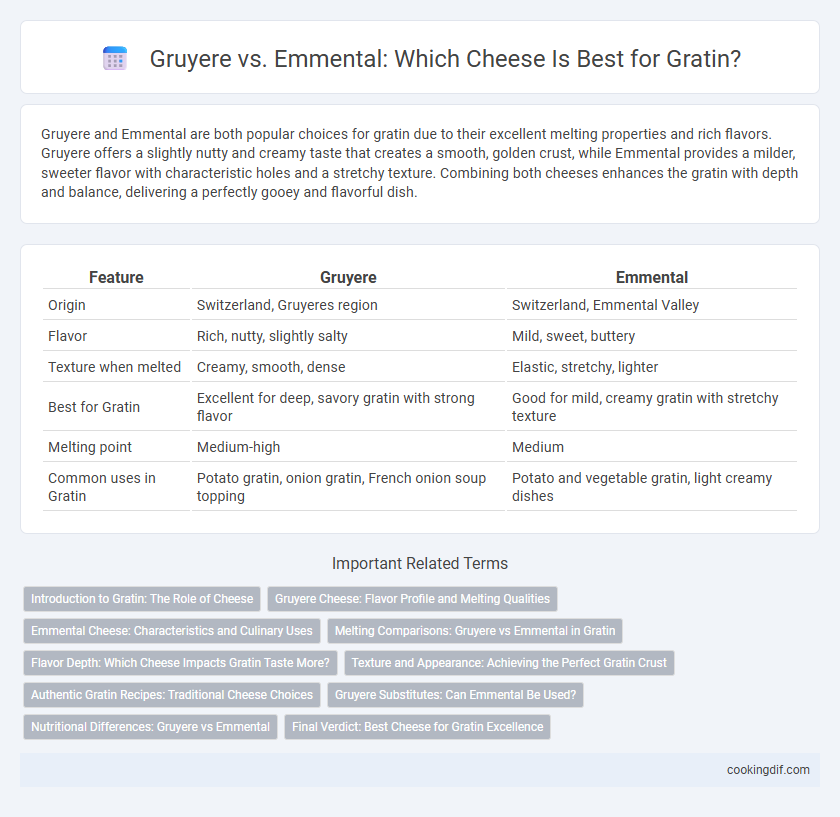Gruyere and Emmental are both popular choices for gratin due to their excellent melting properties and rich flavors. Gruyere offers a slightly nutty and creamy taste that creates a smooth, golden crust, while Emmental provides a milder, sweeter flavor with characteristic holes and a stretchy texture. Combining both cheeses enhances the gratin with depth and balance, delivering a perfectly gooey and flavorful dish.
Table of Comparison
| Feature | Gruyere | Emmental |
|---|---|---|
| Origin | Switzerland, Gruyeres region | Switzerland, Emmental Valley |
| Flavor | Rich, nutty, slightly salty | Mild, sweet, buttery |
| Texture when melted | Creamy, smooth, dense | Elastic, stretchy, lighter |
| Best for Gratin | Excellent for deep, savory gratin with strong flavor | Good for mild, creamy gratin with stretchy texture |
| Melting point | Medium-high | Medium |
| Common uses in Gratin | Potato gratin, onion gratin, French onion soup topping | Potato and vegetable gratin, light creamy dishes |
Introduction to Gratin: The Role of Cheese
Gruyere and Emmental are two quintessential Swiss cheeses often used in gratin dishes due to their superior melting qualities and rich flavors. Gruyere offers a nutty, slightly sweet taste and a creamy texture that creates a smooth, golden crust essential for gratins, while Emmental provides a milder, buttery flavor with characteristic holes that contribute to a light, airy melt. Choosing between Gruyere and Emmental impacts the gratin's texture and depth, with Gruyere delivering a more robust and cohesive melt and Emmental lending a delicate, tender finish.
Gruyere Cheese: Flavor Profile and Melting Qualities
Gruyere cheese offers a rich, nutty flavor with subtle earthy undertones that enhance the depth of any gratin dish. Its excellent melting qualities create a smooth, creamy texture that binds ingredients perfectly without becoming oily or stringy. Compared to Emmental, Gruyere provides a more complex taste and a denser melt, making it the preferred choice for achieving a luxurious gratin.
Emmental Cheese: Characteristics and Culinary Uses
Emmental cheese, recognized for its mild, nutty flavor and excellent melting properties, is a popular choice for gratin dishes. Its smooth texture and ability to create a creamy, golden crust make it ideal for achieving the perfect gratin consistency. Emmental's balanced taste complements vegetables and potatoes without overpowering, enhancing the overall dish with subtle richness.
Melting Comparisons: Gruyere vs Emmental in Gratin
Gruyere melts smoothly with a creamy, slightly nutty texture that forms a rich, golden crust ideal for gratin dishes. Emmental melts more quickly but can become oily and less cohesive, offering a milder flavor and more elastic consistency. For gratin, Gruyere provides superior melt quality and flavor depth, making it the preferred choice for a perfectly browned, creamy finish.
Flavor Depth: Which Cheese Impacts Gratin Taste More?
Gruyere cheese delivers a rich, nutty flavor with a complex depth that elevates gratin dishes by adding creamy, savory notes and a slightly sweet finish. Emmental, while milder and fruitier, provides a smooth melting quality but lacks the intense flavor complexity found in Gruyere. For a gratin with pronounced taste impact, Gruyere influences the dish's flavor more profoundly than Emmental.
Texture and Appearance: Achieving the Perfect Gratin Crust
Gruyere cheese offers a dense and creamy texture that melts smoothly, creating a rich, golden-brown crust ideal for gratin dishes. Emmental provides a lighter, more elastic melt with characteristic holes, resulting in a gratin with a slightly airy, golden appearance. Combining Gruyere's creamy melt and Emmental's elasticity often produces a balanced gratin crust with both smooth texture and visually appealing bubbles.
Authentic Gratin Recipes: Traditional Cheese Choices
Gruyere and Emmental are iconic cheeses used in authentic gratin recipes, each offering distinct flavors and textures that define traditional French gratin dishes. Gruyere provides a rich, nutty taste with excellent melting properties, creating a creamy and slightly browned crust essential for classic gratin. Emmental, lighter and milder with characteristic holes, contributes a gentle aroma and smooth melt, often combined with Gruyere to balance depth and creaminess in traditional gratin preparations.
Gruyere Substitutes: Can Emmental Be Used?
Gruyere and Emmental are both Swiss cheeses known for their excellent melting properties, but Gruyere's rich, nutty flavor and creamy texture make it ideal for gratin dishes. Emmental can be used as a substitute for Gruyere in gratin recipes due to its mild taste and good meltability, although it offers a slightly sweeter and less intense flavor. When substituting Emmental for Gruyere, expect a lighter flavor profile while still achieving the desired golden, bubbly gratin topping.
Nutritional Differences: Gruyere vs Emmental
Gruyere cheese contains approximately 413 calories and 33 grams of fat per 100 grams, offering a richer source of protein with 30 grams compared to Emmental's 29 grams. Emmental provides slightly less saturated fat, around 20 grams per 100 grams, which may be preferable for those monitoring cholesterol intake. Both cheeses are high in calcium, with Gruyere at 1,116 mg and Emmental at 1,060 mg per 100 grams, supporting bone health while adding rich flavor to gratins.
Final Verdict: Best Cheese for Gratin Excellence
Gruyere offers a rich, nutty flavor and melts smoothly, creating a creamy and golden crust ideal for gratin dishes. Emmental provides a milder taste with excellent melting properties but lacks the depth of flavor found in Gruyere. For gratin excellence, Gruyere is the superior choice, delivering both robust taste and optimal texture.
Gruyere vs Emmental for gratin cheese Infographic

 cookingdif.com
cookingdif.com